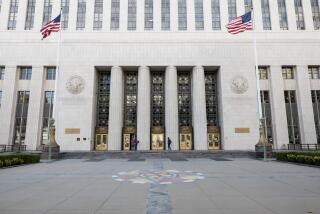The case for cameras
- Share via
Trials in the United States are public. The founders’ deep-seated and eminently rational contempt for secret court proceedings found expression in the 6th Amendment guarantee of a criminal defendant’s right to a public trial, and in statutes and precedents that keep courtrooms open to the public in virtually every case other than a few involving national security, the protection of a child or other rare exceptions.
But in those early days, a trial’s openness was limited by how many observers could squeeze into the courtroom. Film erased those limits more than a century ago, followed by television and the Internet, yet too many courts still do their best to restrict the public nature of trials by prohibiting photographing, recording or televising proceedings. Now the U.S. 9th Circuit Court of Appeals is asking the federal courts’ governing body to reverse its opposition to cameras in federal civil, non-jury trial courts. It’s the right move, belated and unnecessarily narrow though it may be.
Those who insist that courthouse capacity should continue to define how “public” a trial should be tend to rely on a standard list of cautions: Cameras will make lawyers play to the viewing audience. Trials will become entertainment. Courtrooms will become media circuses filled with lights, microphones and video equipment, and photographers jockeying for the best shot. Biased TV programs will take snippets out of context and replay them for their own purposes. The special collegiality that now pervades many courtrooms will be lost. Witnesses will testify differently with an audience than they would without one.
A moment’s reflection should put these assertions to rest. Some lawyers -- in fact, some of the best lawyers -- always have played to the crowd, sometimes to their clients’ benefit, sometimes not. Some trials have attracted sensation-seeking spectators, and newspaper reporters and columnists have long picked out portions of testimony or argument to replay for their readers for their own purposes. The 9th Circuit is contemplating cameras only for civil cases, but the Los Angeles Superior Court learned from the O.J. Simpson circus that with rules, guidelines and careful judging, it’s possible to televise a trial while protecting the rights of the parties and the privacy of jurors and, when appropriate, witnesses.
Federal trial courts too can handle cameras, just as they can handle capacity crowds. Open courtrooms served a crucial role at the nation’s founding by allowing citizens to observe the conduct of their judges and prosecutors, private lawyers, bailiffs and other court personnel, to help them understand and ensure the fairness of the judicial system. They serve the same role today. Courts should not stand in the way of public trials finally becoming truly public.
More to Read
Sign up for Essential California
The most important California stories and recommendations in your inbox every morning.
You may occasionally receive promotional content from the Los Angeles Times.













